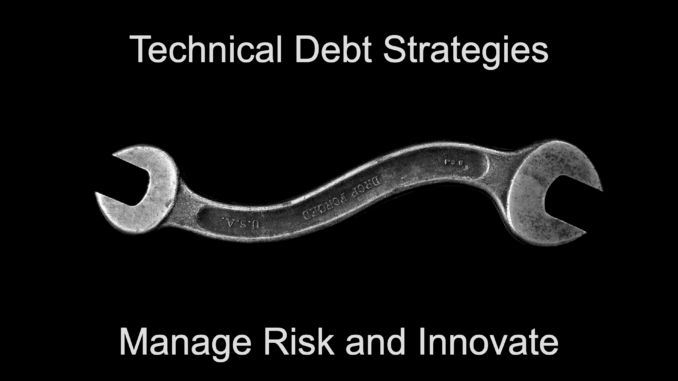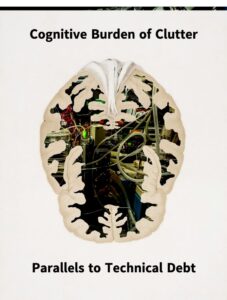
The Cognitive Burden of Clutter: Parallels to Technical Debt in IT Architecture
Over the weekend, I came across a study from Yale published in Neuron that explored the effects of visual clutter on the brain. It was striking—not only for its implications in neuroscience but for its uncanny parallels to one of IT’s most persistent challenges: technical debt.
The study showed how visual clutter disrupts cognitive performance. It drains our mental resources, diminishes focus, reduces working memory, and elevates stress. Over time, it leads to decision fatigue, lowered attention spans, and chronic cognitive overload.
Technical debt creates the same effect—but within an organization’s architecture.
Outdated, fragmented, or overly complex systems become the digital equivalent of cognitive noise. They consume bandwidth, blur clarity, and slow down both decision-making and delivery. What should be a smooth flow from idea to outcome becomes a slog.
Let’s look at a few examples:
- Legacy Systems: Outdated platforms that lag behind security, scalability, or performance standards. They absorb time, attention, and resources while creating friction in transformation.
- System Fragmentation: Portfolios bloated by overlapping tools, duplicated functionality, or siloed data. Each integration adds complexity. Each exception adds entropy.
In short, technical debt introduces a constant low-grade drag on agility. It limits responsiveness. It multiplies cost. And like visual clutter, it contributes to fatigue—especially for architects, engineers, and teams tasked with keeping transformation moving.
So what can we do?
- Assess System Health: Inventory your landscape and identify outdated systems, high-maintenance assets, and unnecessary complexity. Use KPIs like total cost of ownership, incident rates, and integration overhead.
- Prioritize for Renewal or Retirement: Not everything needs to be modernized. Some systems need replacement. Others, thoughtful containment. The key is intentionality.
Just like clearing a cluttered workspace helps you think more clearly, removing technical debt helps your teams deliver more effectively. The result? Better focus, faster change, and a more resilient architecture.
Understanding Technical Debt: Balancing Risk and Agility
In today’s world of rapid iteration and competitive pressure, speed often wins. But speed without balance leads to debt.
Technical debt is a measure of how much operational risk and complexity is lurking beneath the surface. It’s not just code that’s held together by duct tape or documentation gaps—it’s how those issues accumulate and impact business outcomes.
But not all technical debt is created equal.
In fact, some debt is strategic. It enables agility, unlocks short-term wins, and helps organizations experiment quickly. The key is knowing the type of debt you’re dealing with—and managing it accordingly.
Here’s a helpful breakdown of four types of technical debt:
- Planned Debt: Chosen deliberately to meet a short-term goal. For example, reusing a legacy module to accelerate a new feature, knowing it’ll need replacement later.
- Delivered Debt: Introduced by delivery teams, often in the form of quick fixes, compromises, or workaround logic. Common in high-pressure environments where deadlines take precedence.
- Discovered Debt: Found during audits or analysis—like hidden security vulnerabilities or performance bottlenecks that weren’t previously known.
- Acquired Debt: Emerges over time as systems evolve, requirements shift, or entropy sets in. Even good code today becomes outdated tomorrow.
Each type of debt has different implications—and different remediation paths.
Managed poorly, technical debt becomes a liability. Managed well, it becomes a tool.
It’s the difference between innovation with purpose and chaos masked as progress.
The best architects and leaders recognize this balance. They track it, talk about it, and make it visible.
Strategies for Managing Technical Debt
Managing technical debt is less about elimination and more about orchestration. Like financial debt, it’s not inherently bad—but it needs to be understood, tracked, and paid down over time.
Here are three practical strategies to help you do just that:
1. Prioritize Based on Impact
Start with a portfolio view. Use an impact matrix that weighs:
- Security vulnerabilities
- Operational risk
- Change complexity
- Performance implications
Focus first on the liabilities with the highest business risk. Accept some planned or acquired debt if it supports speed—but be sure to plan for its resolution.
2. Refactor Within the Sprint
Make technical debt repayment part of your regular delivery rhythm. Allocate 10–20% of each sprint for refactoring, cleanup, or improving architecture.
- Avoid creating “someday” backlogs.
- Track cumulative debt alongside velocity and delivery KPIs.
- Celebrate when old debt is retired—just like you celebrate new features.
This normalizes debt management and keeps systems maintainable.
3. Use a Risk-Based Innovation Framework
Sometimes, you need to move fast. That’s okay—if you do it with eyes open.
- Take on debt to seize opportunity—but with a documented path to pay it off.
- Build metrics like time-to-resolution, incident rates, and TCO into your architecture dashboards.
- Empower teams to assess trade-offs with data.
This approach gi ves innovation breathing room while still safeguarding sustainability.
ves innovation breathing room while still safeguarding sustainability.
Final Thought
Technical debt is a constant companion on the journey of digital transformation. It’s a byproduct of movement, change, and ambition.
But with visibility, strategy, and a commitment to clean as you build—it doesn’t have to slow you down.
In fact, when you manage technical debt well, it becomes part of your innovation engine—not an anchor holding it back.
Kevin Donovan is a strategic global IT executive and Enterprise Architect withover 20 years of experience leading digital transformation and innovation initiatives across Fortune 500 companies, consulting firms and government agencies. Kevin has guided impactful architecture strategies for companies like EPAM Systems and W.W. Grainger, where he has built global IT architectures, driven cloud transformations and developed innovative data and API-first platforms. He holds an M.S. in Computer Science from the University of Aarhus and is a certified TOGAF practitioner, fluent in both English and Danish. Kevin currently advises clients as Chief Architect for WVE.
